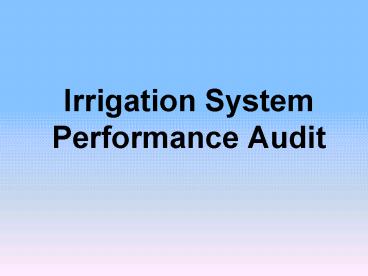Irrigation System Performance Audit - PowerPoint PPT Presentation
1 / 65
Title: Irrigation System Performance Audit
1
Irrigation System Performance Audit
2
Class Objectives
- be able to perform field audits on irrigation
systems - be able to identify problems that cause poor
uniformity
3
Key Irrigation Auditor Actions
- Identify equipment problems
- Determine actual system performance based on
uniformity tests - Adjust run times for seasonal variations
4
Water savings achieved by
- Checking and fixing equipment
- Following the weather throughout the season
- Maintaining the system at peak efficiency
5
ConceptsandProblems
6
Water Application and Uniformity
7
System Problem Nozzle too low!
8
Sprinkler arc incorrectly set!
9
System Problem Missing nozzles!
10
Watch out for low-pressure discharge.
11
System Problem Pressure too high!
12
Runoff caused by excess run time!
13
Infiltration Rate in./h
- Rate at which water moves into soil
- Sandy soils accept water rapidly
- Heavy soils accept water slowly
- Decreases during irrigation
14
Infiltration vs. Precipitation
15
Precipitation Rate (in./h)
- How fast does system apply water?
- Varies from station to station
- Even varies within a station
- Many systems precipitation rates exceed the
infiltration rate
16
Theoretical Precipitation Rate (in./h)
- Q flow rate into area (gpm)
- A area (sq. feet)
17
Matched Precipitation Rate(MPR)
- Nozzle flow rate is in proportion to the area
covered - Watering time is in proportion to the area
covered - You must verify during the site inspection
- Can drastically alter the uniformity
18
Matched Precipitation
19
To the field!
20
Site Inspection
- Step one get the system
- working right
21
Equipment used in audit
22
Site Inspection Priorities(what to repair)
- Minor, not major repairs
- Low heads
- Plugged heads
- Tilted heads
- No matched precipitation rate
- Mixed unmatched heads
23
Information to Collect in the Site Inspection
- Site conditions
- Point of connection data
- Controller data
- Brand of products used
- Pressure at nozzles
24
Pitot tube for measuring pressure
25
Using Pitot Tube
26
Checking pressure at nozzle
27
Different nozzles and brands will require
different setups!
28
Sill Cock Adaptor
29
Catch Devices
- Calculate falling water from sprinklers
- Used to determine precipitation rate uniformity
- All catch devices must be identical
- May measure in millimeters or inches
- Volume measurement with a wide throat area allows
for shorter test times
30
Homemade Catch Can
Homemade Catch Can
31
Commercial Catch Can
32
Bureau of ReclamationCatch Can
33
Laying out catch cans
Head locations
34
Using tape to locate heads and catch cans
35
Catch Device Placement-Rectangular
Sidewalks
Sprinkler Head Catch Can (in station)
Catch Can between stations
36
Catch Device Placement - Triangular
Station 1
Station 2
Station 3
1/2
2/3
Sprinkler Head Catch Can (in station)
Catch Can between stations
37
Testing area with irregular boundaries
38
Testing grass strip
39
Setting up catch cans near hardscape
40
Problem!Spray hitting side of catch can.
41
Recessed Container
42
Catch Device Placement
43
Collect other data duringstation runs.
- Spacing of sprinklers
- head to head
- line-to-line
- Test soil type and root zone depth
44
Spacing Measurement
45
Running the Test
46
Run test during typical wind conditions!
47
Maintain wind below 5 mph.
48
Collecting Data
49
Collecting Data
50
Analyzing Data
51
Calculating Precipitation Rate (Net Precip.)
- PR Precipitation Rate (in./h)
- CV avg Average Catch Can Volume (ml)
- 3.66 conversion constant
- TR Testing Runtime (minutes)
- CDA Catch Can Throat Area (sq in.)
52
Precip. Rate Sample Calculation
53
Precipitation Rate
54
DULQ
- One way of measuring system uniformity
- Average of the lowest 25 of catchments divided
by the average total catchments
55
Distribution Uniformity(D.U.)()
56
Lower Quarter Distribution Uniformity (DULQ)
57
DistributionUniformity
58
CU and SC
- Other Methods of Calculating Uniformity
- Coefficient of uniformity
- Scheduling coefficient
59
Scheduling Coefficient
60
SchedulingCoefficient
61
Run Time
62
Key Irrigation Auditor Actions
- Identify equipment problems
- Determine actual system performance based on
uniformity tests
63
Site Report
- Letter format for management review
- Formal document/ report (see example)
- Document hardware changes to consider
64
Recap Key Actions
- Identify equipment problems
- Repair problems
- Determine actual system performance based on
uniformity tests - Make recommendations for improvement
65
The End































